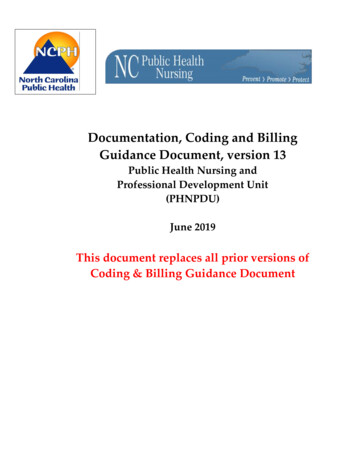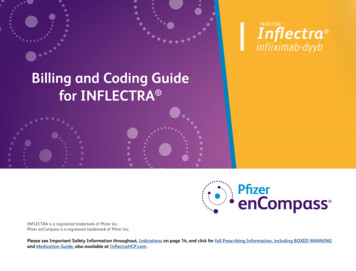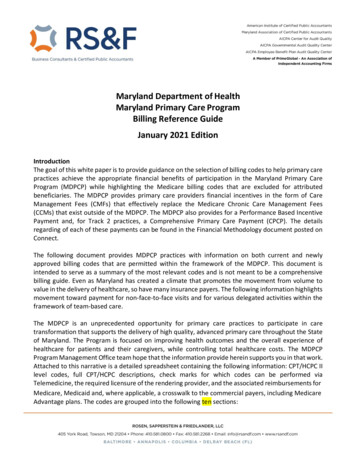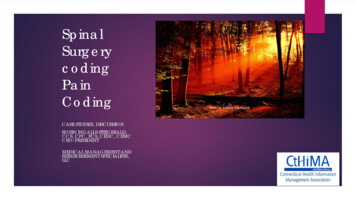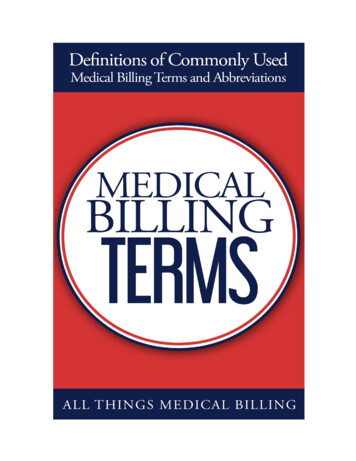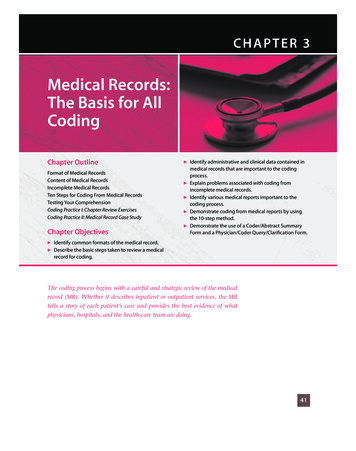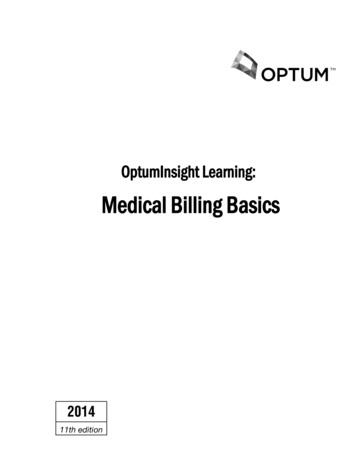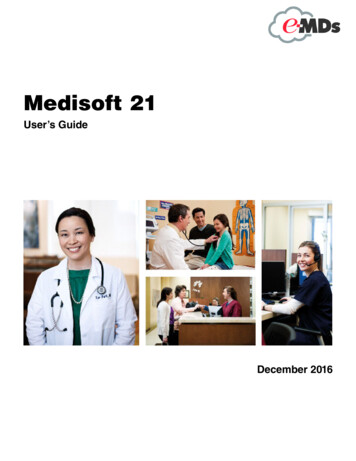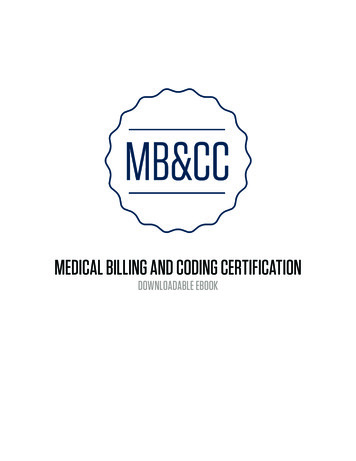
Transcription
MEDICAL BILLING AND CODING CERTIFICATIONDOWNLOADABLE EBOOK
2 TABLE OF CONTENTSTABLE OF CONTENTSIntroduction5SECTION 1What is Medical Billing and Coding?Working in Medical Billing and CodingMedical Coding CertificationMedical Billing Certification681214SECTION 2Learn More About Medical CodingMedical Coding Vocabulary & Key TermsICD-9 & ICD-9-CMUsing ICD-9-CMICD-10-CMUsing ICD-10-CMIntro to CPTUsing CPTCPT ModifiersHuman Anatomy and Medical TerminologyHCPCS CodesHCPCS ModifiersCrosswalkingElectronic vs. Paper CodingMedical Coding Review162226343844485460687882869092SECTION 3Introduction to Medical BillingMedical Billing VocabularyThe Medical Billing ProcessMore About Insurance and the Insurance Claims ProcessMedicare & MedicaidMedicare, Medicaid and Medical BillingPotential Billing Problems and Returned ClaimsHIPAA 101HIPAA and Medical BillingMedical Billing Review98102108112116120122126130132SECTION 4Try Medical CodingTry Medical BillingCommon Problems in Medical Coding136142146
TABLE OF CONTENTS 3TABLE OF CONTENTSSECTION 5What is the CPC Exam?General Preparation and Test Strategies for the CPC ExamCPC Exam: AnesthesiaCPC Exam: RadiologyCPC Exam: MedicineCPC Exam: The Nervous SystemCPC Exam: the Endocrine SystemCPC Exam: Digestive SystemCPC Exam: The Urinary SystemCPC Exam: The Musculoskeletal SystemCPC Exam: Evaluation and ManagementCPC Exam: Anatomy and PhysiologyCPC Exam: Mediastinum and DiaphragmCPC Exam: Practice ManagementCPC Exam: Male and Female Genital SystemCPC Exam: Hemic and Lymphatic SystemCPC Exam: Maternity and DeliveryCPC Exam: Eye and Ocular AdnexaCPC Exam: ICD-9-CMCPC Exam: HCPCS Level IICPC Exam: Coding GuidelinesCPC Exam: Medical TerminologyCPC Exam: Pathology and LaboratoryCPC Exam: IntegumentaryCPC Exam: Respiratory SystemCPC Exam: Cardiovascular SystemCPC Exam: Where to Take an ExamThe CPC Apprentice ProgramThe CPB 92194196198200202204208210212214216218220SECTION 6Accredited Billing and Coding SchoolsHow to Recognize Industry ScamsGetting Your First Medical Billing and Coding Job222226228
4 INTRODUCTION
INTRODUCTION 5INTRODUCTIONThis ebook will brief you on every aspect of the medical billing and codingfield: from a breakdown of each code set to starting your own practice.DOWNLOADABLE MATERIALAlong with our online video courses, we provide free downloadable resourceslike Powerpoint presentations, vocabulary lists, sample problems, and reviewquizzes to help you in your studies.The course is divided into six sections. In section one, we introduce you tothe general topic of medical billing and coding.In section two, we talk about the practice and the basics of the medical codingprocess.In section three, you learn about the medical billing claims process and how itpertains to health insurance payers, Medicare and Medicaid, and the rest of thehealthcare industry.In section four, we apply the knowledge you’ve learned and work with somereal-world problems in coding and billing. This section gives you a detailedlook into what it’s like to work as a medical coder or biller.In section five, we help you prepare for the American Association of Professional Coder’s Certified Professional Coder exam.And finally, in section six we show you some of the next steps to take in thefield, including where to go to school, where to get certified, and how to avoidonline scams.DISCLAIMERBear in mind that this ebook, and all our provided content on our website alonewill not prepare you to take the exams to become a certified medical biller orcoder. In order to learn the specifics of these fields and prepare yourself fortheir exams, you’ll want to take classes at one of the many schools and trainingprograms around the country. You can count on us for that, too: our website canhelp you pick out the school or training program that’s right for you.Let’s get started!
6 SECTION 1WHAT IS MEDICAL BILLING AND CODING?Medical billing and coding are two closely related aspects of the modernhealth care industry. Both practices are involved in the immensely importantreimbursement cycle, which ensures that health care providers are paid forthe services they perform.MEDICAL CODINGMedical coding, at it’s most basic, is a little like translation. It’s the coder’sjob to take something that’s written one way (a doctor’s diagnosis, forexample, or a prescription for a certain medication) and translate it asaccurately as possible into a numeric or alphanumeric code. For everyinjury, diagnosis, and medical procedure, there is a corresponding code.There are thousands and thousands of codes for medical procedures, outpatient procedures, and diagnoses. We’ll cover which codes represent whichinjury or sickness, and which codes correspond to each procedure,in greater depth in Section 2.For now, let’s start with a quick example of medical coding in action.MEDICAL CODING EXAMPLEA patient walks into a doctor’s office with a hacking cough, high productionof mucus or sputum, and a fever. A nurse asks the patient their symptomsand performs some initial tests, and then the doctor examines the patientand diagnoses bronchitis. The doctor then prescribes medicationto the patient.Every part of this visit it recorded by the doctor or someone in the healthcareprovider’s office. It’s the medical coder’s job to translate every bit of relevantinformation in that patient’s visit into numeric and alphanumeric codes,which can then be used in the billing process.There are a number of sets and subsets of code that a medical coder mustbe familiar with, but for this example we’ll focus on two: the InternationalClassification of Diseases, or ICD, codes, which correspond to a patient’s injuryor sickness, and Current Procedure Terminology, or CPT, codes, which relateto what functions and services the healthcare provider performed on or forthe patient. These codes act as the universal language between doctors, hospitals, insurance companies, insurance clearinghouses, government agencies,and other health-specific organizations.The coder reads the healthcare provider’s report of the patient’s visit and thentranslates each bit of information into a code. There’s a specific code for whatkind of visit this is, the symptoms that patient is showing, what tests the doctordoes, and what the doctor diagnoses the patient with.Every code set has its own set of guidelines and rules. Certain codes, like onesthat signify a pre-existing condition, need to be placed in a very particularorder. Coding accurately and within the specific guidelines for each code willaffect the status of a claim.
WHAT IS MEDICAL BILLING AND CODING? 7The codes for the procedures performed must also correspond to the diagnosesmade by the physician. Having the correct procedure codes match up with thediagnosis codes ensures that healthcare providers and patients will be properlyreimbursed by insurance companies.The coding process ends when the medical coder enters the appropriate codesinto a form or software program. Once the report is coded, it’spassed on to the medical biller.MEDICAL BILLINGOn one level, medical billing is as simple as it sounds: medical billers take theinformation from the medical coder and make a bill for the insurance company. This bill is called a claim, and will be discussed more in depthin Section 3. The biller also receives evaluated or ‘adjudicated’ claims,analyzes them, and then creates bills for patients.Of course, as with everything related to the health care system, thisprocess isn’t as simple as it seems.MEDICAL BILLING EXAMPLETo get a better look at medical billing, let’s rewind the example we used earlier.Our same patient has a cough, a fever, and is producing lots of mucus. This patient calls the doctor and schedules an appointment. It’s here that the medicalbilling process begins.The medical biller takes the codes, which show what kind of visit this is,what symptoms the patient shows, what the doctor’s diagnosis is, and whatthe doctor prescribes, and creates a claim out of these using a form or a typeof software. The biller then sends this claim to the insurance company, whichevaluates and returns it. The biller then evaluates this returned claim and figures out how much of the bill the patient owes, after the insurance is taken out.If our bronchitis-afflicted patient has an insurance plan that covers this typeof visit and the treatment for this condition, their bill will be relatively low.The patient may have a co-pay, or have some other form of arrangement withtheir insurance company. The biller takes all of this into account and createsan accurate bill, which is then passed on to the patient.In the case of a patient being delinquent or unwilling to pay the bill, the medical biller may have to hire a collections agency in order to ensure that thehealthcare provider is properly compensated.The medical biller, acts as a sort of waypoint between patients, healthcareproviders, and insurance companies. Think of the biller, like the coder, as asort of translator—where the coder translates medical procedures into code,the biller translates codes into a financial report. The biller has a number ofother responsibilities, which we’ll discuss further in Section 3, but for now youshould simply know that the biller is in charge of making sure the healthcareprovider is properly reimbursed for their services.
8 SECTION 1WORKING IN MEDICAL BILLING AND CODINGNow is a very good time to look at a career in medical billing and coding. TheAmerican health care system is modernizing just as a large portion of the populace enters retirement, and the demand for healthcare professionals who canprocess crucial data is growing daily.According to the Bureau of Labor and Statistics, the medical billing and codingfield is expected to grow by 21% between now and 2020. That’s almost 40,000job openings in the next six to seven years.Not only are there a large number of job openings in coding and billing, manyof these jobs are fairly lucrative. Entry-level coders and billers made an averageof 34,000 dollars in 2012—that’s 16.42 an hour when you’re starting out. Thetop ten percent of coders across the United States make 27 an hour, and codersin some states make even more than that.The field of medical billing and coding is growing as a result of a number offactors, chief among them being an aging population, an increasing focus onhealth data and informatics, and the digitization of health records. As thehealth care system turns increasingly to electronic health records, billing andcoding specialists who are computer-savvy will have a leg up on the rest of field.Let’s now take a look at some of the day-to-day tasks performed by professionalmedical coders and billers. As with the previous course (What is Medical Billingand Coding?), we’ll divide this course into two sections to look at the daily activities of a medical biller and a medical coder. Bear in mind that, occasionally, oneperson performs the duties of both positions.MEDICAL CODINGProfessional coders start the day by reviewing the reports they have to code.Their job is relatively straightforward: a coder examines a doctor’s report froma procedure or checkup, and then the coder determines the best way to translatethis into code.MEDICAL CODING EXAMPLEFor example, a note may read that a patient visited the doctor with a sore throat.Upon examination of the throat, the doctor suspected streptococcus, a commoninfection of the throat. The doctor performed a rapid strep test. With a positivediagnosis of strep throat, the doctor prescribed a week’s worth of amoxicillin,an antibiotic drug.The coder would read this note and, using the ICD-9-CM and CPT manuals,determine the best way to code this diagnosis and procedure. In this instance,the coder would use a CPT code of 87880 for the rapid strep test, a CPT code of00781-6041 for the prescription of orally administered amoxicillin, and anICD-9-CM code of 680.0, for streptococcal sore throat.The coder will then enter the correct codes into a form or, more often, a computer program, and then move on to the next report. This process of readingreports, translating them into the correct code and entering them will continue
WORKING IN MEDICAL BILLING AND CODING 9for the rest of the day. Most coding is relatively straightforward, and mostcoders become familiar with the codes for the more common procedurescompleted in their respective office. A coder for a general practitioner, forexample, will become very familiar with the codes for a general office visit(99214) and flu shots (90658). Coders must adhere to the guidelines for eachcode. Certain conditions, for example, need to be coded in a particular order.To learn more about coding guidelines, please refer to Section 2, specificallythe courses ICD-9 & ICD-9-CM through CPT Modifiers.Still, there may be instances where there is significant confusion or a gray areain the code. Coding guidelines may also get incredibly intricate and specificas the symptoms, conditions, or procedures performed get more complicated.In cases where referring to the appropriate manuals and their guidelines isnot sufficient, most coders will reach out to the larger coding community foradvice and guidance.Above all else, the coder must make sure that the procedure code used corresponds to the diagnosis code. If the procedure listed does not make sense withthe diagnosis provided, this may result in a rejected claim, which can muddythe reimbursement process considerably.One last point: Each medical office has a specific lag time for coding reports.This lag time is typically two to five business days. That means that codersmust complete their coding within five days of the procedure or doctor’s visit.Hitting these deadlines ensures that the billing and reimbursement processcan move along smoothly. It’s the coder’s responsibility to manage these deadlines and work in a timely, efficient manner.MEDICAL BILLINGThe job
To get a better look at medical billing, let’s rewind the example we used earlier. Our same patient has a cough, a fever, and is producing lots of mucus. This pa-tient calls the doctor and schedules an appointment. It’s here that the medical billing process begins. The medical biller takes the codes, which show what kind of visit this is,File Size: 1MBPage Count: 229
